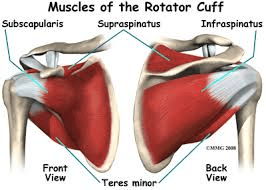
The rotator cuff consists of four deep muscles in your shoulder which work together to keep the shoulder stable while you move it. In other words, they are the muscles that work really hard to stop your shoulder from dislocating.
The diagram below shows the four muscles of the rotator cuff; supraspinatus, infraspinatus, teres minor, and subscapularis. They sit underneath the bigger muscles of your shoulder which are responsible for moving your arm around.
 How does the rotator cuff get injured?
How does the rotator cuff get injured?
There are many ways the rotator cuff can be injured. A sudden (acute) tear can be caused by one major incident such as falling onto your arm or lifting an object awkwardly. Tears can also occur gradually over time from repetitive overhead tasks such as throwing or swimming. It is also common for degenerative tears to develop in older people – which is a perfectly normal part of the ageing process (just like grey hair, really). Some of these degenerative tears won’t ever cause pain or physical limitation, but some can become painful.
Research has shown that 20-30% of people aged over 50 with NO SYMPTOMS have a rotator cuff tear… And this number increases with age!
The rotator cuff isn’t the only injury that can occur to your shoulder. You can read more about these other shoulder injuries in our previous post here.
Many different factors come into play when deciding the best management option.
For most tears which occur gradually or tears in older people, a period of carefully progressed strengthening should be the first treatment option. This aims to strengthen the other muscles in your shoulder and increase your overall function. If you are not happy with how your shoulder is progressing after 6-8 weeks then surgical review can be considered.
For acute tears – those that are the result of a trauma or incident, some will need a surgical review straight away. In other cases, a period of strengthening will be recommended. Some of the factors influencing the decision for surgical review straight away include:
The debate about surgical vs non-surgical treatment for rotator cuff tears is a hot topic among researchers, with no clear evidence supporting one over the other… So make sure you stay tuned for updates as future evidence becomes available!
Surgery involves re-attaching the torn part of the rotator cuff tendon to the bone in your shoulder (humerus). This is done by threading small tightropes through the tendon and attaching it to screws which have been placed into your humerus.

Rotator Cuff Tear with obvious disruption of fibres.

Surgical repair of rotator cuff injury
This is followed by 4-6 months of rehabilitation aiming to gradually progress you back to your
previous activities. For most protocols, the first 3-6 weeks involves wearing a sling and only gentle
stretches for your shoulder. This is followed by a progressive strengthening program with common
timeframes including:
However, these timeframes are just a guide and will differ from person to person. Returning to tasks
is criteria based, which means certain levels of movement, strength and comfort must be reached
before returning to activities, rather than waiting a certain amount of time.

Exercise is an important part of rehabilitation, whether or not there is a surgical repair.
The best treatment option varies greatly depending on you, the needs of your shoulder and the tear you present with. Having surgery is a big deal, so all other options should be considered (and in some cases trialled) before a surgical review is considered. As Physio’s we can help educate you about the different treatment options and guide you through the decision making process.